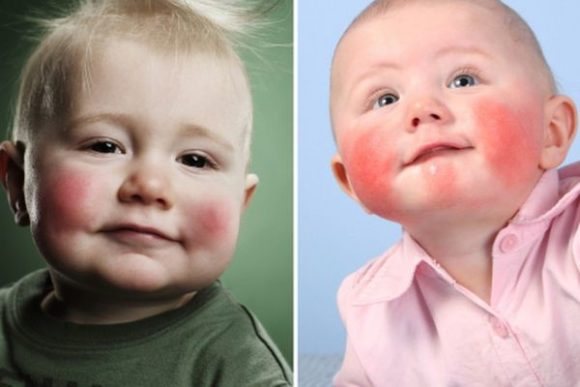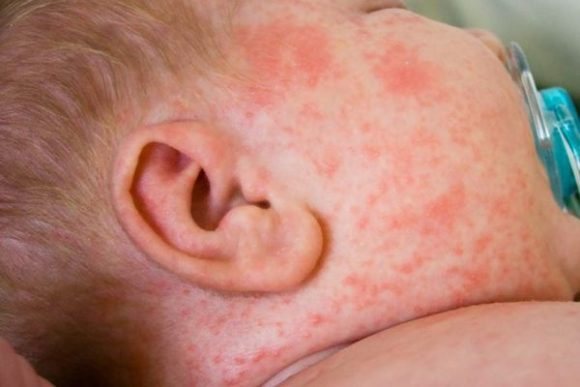About the types of diathesis and the reasons for their occurrence
Diathesis in an infant can occur quite early, even in the prenatal period. However, most often the manifestation of the disease occurs some time after birth.
The disease can be of the following types:
- allergic (exudative-catarrhal);
- atopic;
- autoimmune;
- infectious-allergic;
- neuro-arthritic;
- lymphatic-hypoplastic.
If you understand why the disease occurs, we can distinguish several types:
- Food. Basically, the trigger for such diathesis is a foreign protein that enters the child’s body with food. When breastfeeding, protein comes from mother's milk; If your child eats formula, you should choose it wisely.
- Respiratory. The reason for such diathesis can be any irritant that enters the baby’s body through the respiratory tract. In this case we are talking about diseases such as sinusitis, allergic rhinitis or conjunctivitis.
- Contact. We are talking about contact dermatitis, when the disease can be triggered by laundry detergent, baby wipes or even diapers.
What does this problem mean?
The word “diathesis” is used by many - from parents of babies, their grandmothers and ending with pediatricians - meaning by it a rash that appears in young children.
However, in fact, this is not a scientific diagnosis, not a disease, but only a predisposition to some kind of disease.
And most often it refers to the initial stage of atopic dermatitis.
Atopic dermatitis is an allergic disease. The fact is that in infancy, an insufficient amount of digestive enzymes is produced and the immune system is weakened, and the permeability of the intestinal wall is high.
Therefore, undigested food (especially proteins) is easily absorbed into the blood, causing an allergic reaction.
With age, children's digestive system improves, the liver copes better with removing toxins, and the immune system is strengthened.
Therefore, diathesis can go away on its own.
But it is still necessary to treat this disease, as it can develop into other allergic diseases, including bronchial asthma.
What mixtures should be preferred for diathesis?
If it so happens that your baby does develop allergic dermatitis, you should choose the mixture wisely. Thus, artificial nutrition should not contain large amounts of cow's milk proteins, since experts believe that it is this component that increases the risk of disease.

Parents should pay attention to the following mixtures:
- Acidophilus - such mixtures are recommended even for those babies who are fed breast milk, which, unlike formulas, contains lactose. Such nutrition can not only relieve symptoms and eliminate manifestations of diathesis, but also normalizes stool, relieving the baby of signs of dysbiosis. In such mixtures, during fermentation, the protein changes its structure and loses its antigenic properties.
- Soy - these mixtures are recommended for use when diathesis is already pronounced, since they contain soy protein. In addition, such mixtures do not contain lactose.
Nature of diathesis
Diathesis is not a disease, the skin shows all the internal problems of a person, a pathological reaction to irritants, everything that is on the surface of the skin is a mirror image of the internal organs.
When constant rashes begin on the body, it is necessary to conduct a professional medical examination of the child’s body to find out the true cause, whether it is a reaction to an allergen or a serious pathology; in the second case, it is recommended to begin treatment immediately.
But fortunately, the most common causes of eczema are not a serious pathology, but an allergic reaction to an external irritant.
How to treat diathesis in infants
Treatment of a disease in an infant should have an integrated approach; this is the only way to achieve positive dynamics, and possibly prevent a recurrence of the disease in the future.

Antihistamines
For dermatitis, allergy medications may be prescribed. In particular, if you use first-generation drugs, which additionally have a slight sedative effect, you can ensure that a restless baby becomes quieter. The course of treatment is from 10 to 14 days. Doctors recommend changing the drug every 5 days.
If we talk about second-generation drugs, their action is aimed at achieving an anti-allergenic effect, and they do not have sedative properties, and therefore they can be taken for several weeks.
Enterosorbents
Enterosorbents are also important in the fight against diathesis, as they cleanse the baby’s body of allergens. By the way, even nursing mothers can take them. So, the sorbent can be mixed with any baby cream and applied directly to the affected areas of the skin.

Probiotics and prebiotics
These drugs also play an important role in the complex treatment of diathesis. To choose the right probiotic and prebiotic, you should consult your pediatrician.
Diet of a nursing mother with diathesis in a child
A mother’s diet during diathesis in a child is one of the main conditions for the baby’s rapid recovery. A nursing mother should exclude all potential allergens from her diet, after consulting with her doctor. To determine which food the body responds to in an atypical manner, a rotational diet may be required.
It is advisable to keep a food diary where you can record all the nuances of a nursing mother’s diet during diathesis. In the diary it is recommended to indicate the name of the dishes, the weight of the portion, the time elapsed between eating and feeding the baby, and his reaction to mother's milk.
Other features of feeding children with diathesis
If a child already has manifestations of diathesis, it is necessary to adhere to certain rules when feeding. So, if a mother is feeding her baby with breast milk, she should carefully review her diet. Ideally, you should exclude the consumption of all foods that can cause a negative reaction in the baby - sweets, red vegetables and fruits, animal protein.

After a short period of abstinence from food, you can gradually begin to add them back to your diet, observing the baby’s reaction. In this way, the mother can discover what exactly is the irritating factor.
If the child is bottle-fed, it is necessary to clearly monitor the exact amount of formula the baby receives, so that it is not higher than normal, because this factor can be decisive in the emergence of a problem. In the case where the standards are not exceeded, but there are symptoms of the disease, it is worth trying to change the mixture. To choose a new diet, it is best to consult your pediatrician.
Diathesis in newborns during breastfeeding
Skin rashes in children under one year of age are determined by heredity, nutrition and care conditions. Diathesis in newborns as inflammation of the skin on the face or hands is one of the manifestations of an allergic reaction. When is a baby more likely to develop diathesis, what are the consequences of an advanced condition and how to prevent the development of diathesis in an infant thanks to a diet that includes “goat” formula, explains Ph.D., doctor of the highest category, pediatrician and deputy head of the children's hospital on Savelovskaya Alla Anatolyevna Shcherbakova.
— Alla Anatolyevna, diathesis occurs with surprising frequency in infants. What is this anomaly and why does diathesis occur at a very early age, in newborns?
— Diathesis is a word of Greek origin, which from a doctor’s point of view means a hereditary predisposition to the development of certain pathological conditions. In a routine sense, diathesis is a rash on the skin of a child in infancy (atopic dermatitis).
The newborn period lasts the first 28 days of life, after which the child is called an infant. The debut of diathesis in the form of an inflammatory condition of the skin most often occurs in the transition period from newborn to infancy - at 3-5 weeks.
Diathesis is not a diagnosis, but a predisposition of the body of young children to allergic reactions. The most common form of allergic diathesis is atopic dermatitis (food allergy). In 99% of cases it is detected in the first three months of life. Other forms of dermatitis in children - diaper, contact, seborrheic - also often appear in early infancy.
— How does diathesis manifest in infants and how to distinguish diathesis from allergies?
- Rashes on the cheeks, redness on the face, dry skin, peeling, redness and rash on the bends of the elbows and knees, feet, itching - all these are manifestations of atopic dermatitis (skin form of food allergy). If a child has similar complaints, then this is not a diathesis, but rather symptoms of a food allergy, which over time is accompanied by a secondary infection in the form of streptoderma. Due to its external manifestations, mothers usually call dermatitis diathesis.

— What are the types of diathesis, how to distinguish one from another?
— Diathesis in infants is regarded as a constitutional anomaly. There are several types of this condition, but in young children the most common form is allergic dermatitis.
| Exudative-catarrhal diathesis (allergic dermatitis) |
|
| Lymphatic-hypoplastic diathesis |
|
| Neuro-arthritic (uric acid) diathesis |
|
— Is the tendency to develop diathesis inherited?
- Yes, of course, the type of constitution is passed on from mom, dad or close relatives. But the risk of developing allergic reactions (diathesis) in the form of atopic dermatitis against this background is higher in children whose immediate relatives (parents, brothers, sisters) suffered from allergies. But there are children who, even without a family history, have allergies and skin rashes.
— Are there foods that provoke the development of diathesis?
— Any product can cause diathesis, that is, become an allergen and provoke an allergic disease. In newborns and babies 2-3-4-5 months of life, cow protein most often becomes an allergen, followed by wheat protein. Older babies have allergens from “adult” life: soy, peanuts, fish, seafood, eggs, tree nuts. They can cause diathesis and immediate anaphylactic reactions that last a lifetime.
— Breastfed children are dependent on the diet of the nursing mother. How does a mother’s diet affect the prevention and treatment of diathesis in infants during breastfeeding?
— Prevention of diathesis is the mother’s diet with limited cow’s milk proteins, which reduces the risk of developing allergies in the baby. If there are signs of diathesis, it is important to adhere to a completely dairy-free diet to help the child get rid of the painful condition.

Mother's nutrition depending on the baby's condition during breastfeeding
| The child is healthy, there are no complaints, the medical history is not burdensome |
|
| The child has no complaints, but has a burdened medical history (food allergies in parents, relatives) |
|
| A child has manifestations of food allergies (skin red, dry, diathesis, atopic) |
|
— Alla Anatolyevna, in case of acute diathesis, can infant formula be administered to infants receiving mother’s milk?
— If a breastfed baby shows signs of a food allergy, the mother should be prescribed a dairy-free diet. When cow protein disappears from the mother's diet, it will no longer appear in breast milk, and this will be the child's treatment for his reaction to food.
It also happens that even after a month of a mother’s completely dairy-free diet, the baby still has skin problems. The reason is that breast milk is a living liquid and cannot eliminate all the factors that cause allergic dermatitis. Then the child is transferred to a special split formula. The family and the doctor wait for positive dynamics, remission, and monitor the little patient’s condition. During the period of treatment of the baby, it is important for the mother to pump in order to stimulate lactation and later return to breastfeeding.
— Can diathesis appear on artificial feeding? How does this diathesis differ from the allergic condition that occurs during breastfeeding?
— Diathesis can develop both with natural and artificial feeding. But breast milk reduces the risk of developing diathesis, and when feeding infants with cow's milk-based powdered milk formula, the risk of having diathesis from birth increases.
If an artificial child has a history of allergic conditions (even without complaints), it is better to choose a hypoallergenic formula. Cow protein formula should not be chosen for children prone to allergies.
— Goat milk is considered hypoallergenic. Are milk “goat” formulas allowed for diathesis?
— They are allowed, they are introduced into the diet of healthy children with a medical history, because goat milk proteins are truly hypoallergenic. In addition, approximately nine percent of children with a sensitivity to cow's milk proteins can tolerate goat's milk. But in case of complaints and the occurrence of allergic reactions and diathesis, the baby will be prescribed a medicinal mixture.

The digestion-friendly formula MAMAKO® Premium is a formula for healthy babies that can be used to reduce the risk of developing diathesis.
— How to cure diathesis on the cheeks of a baby? Is it possible to treat diathesis at home with folk remedies?
— Skin rashes and manifestations of diathesis in an infant are a signal to definitely consult a doctor. Treatment in this case will be the selection of nutrition: a diet for a nursing woman, a medicinal mixture for an artificial child.
Special therapy in the form of antihistamines, probiotics or antibiotics should not be prescribed. At home, a mother can nourish the baby’s dry skin with a moisturizer - ointment or cream for atopic skin, but this is not a solution to the problem, but a hiding of the symptoms.
What not to do if there are signs of diathesis in newborns:
- change the powdered milk mixture as desired;
- give any drugs or medications;
- bathe the child in potassium permanganate or in a series.
A child's skin is a thin, delicate organ that can become infected. Therefore, if you have diathesis, you should not self-medicate. This can lead to negative consequences in the future and have a more serious impact on the child’s condition.
— Why is diathesis dangerous in infants and why is it better to treat it in the early stages?
— The onset of diathesis (the debut of the atopic march, the onset of allergic manifestations) is most often noted in the first months of life. This onset may not stop, and the allergy will accompany the child for the rest of his life, but not in the form of childhood atopic dermatitis, but in adult forms. These are hay fever seasonal runny nose, intolerance to animal hair and plant pollen, bronchial asthma and other expressions of allergic reactions. Therefore, treatment of diathesis in an infant is to stop the atopic march in the future, reducing the risk of allergic reactions in older age.
Diathesis is a predisposition, not a diagnosis. We call red cheeks and skin rashes diathesis, while this allergic manifestation is atopic dermatitis. Diathesis occurs from dairy foods: human breast milk or formula. Therefore, the treatment of diathesis is the selection of nutrition during natural and artificial feeding.
Pediatrician Alla Anatolyevna Shcherbakova
*The ideal food for an infant is mother's milk. WHO recommends exclusive breastfeeding for the first 6 months. MAMAKO® supports this recommendation. Before introducing new foods into your baby’s diet, consult a specialist.








